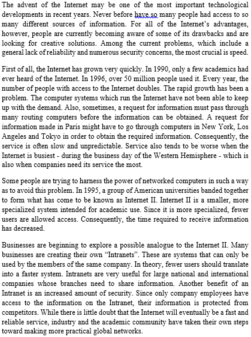Read the following passage and mark the letter A, B, C or D to indicate the correct answer to each of the questions from 43 to 50.
It is estimated that over 99 percent of all species that ever existed have become extinct. What causes extinction? When a species is no longer adapted to a changed environment, it may perish. The exact causes of a species' death vary from situation to situation. Rapid ecological change may render an environment hostile to a species. For example, temperatures may change and a species may not be adapted. Food resources may be affected by environmental changes, which will then cause problems for a species requiring these resources. Other species may become better adapted to an environment, resulting in competition and, ultimately, in the death of a species.
The fossil record reveals that extinction has occurred throughout the history of Earth. Recent analyses have also revealed that on some occasions many species became extinct at the same time - a mass extinction. One of the best-known examples of mass extinction occurred 65 million years ago with the demise of dinosaurs and many other forms of life. Perhaps the largest mass extinction was the one that occurred 225 million years ago, when approximately 95 percent of all species died. Mass extinctions can be caused by a relatively rapid change in the environment and can be worsened by the close interrelationship of many species. If, for example, something were to happen to destroy much of the plankton in the oceans, then the oxygen content of Earth would drop, even affect organisms not living in the oceans. Such a change would probably lead to a mass extinction.
One interesting, and controversial, finding is that extinctions during the past 250 million years have tended to be more intense every 26 million years. The periodic extinction might be due to intersection of the earth's orbit with a cloud of comets, but this theory is purely speculative. Some researchers have also speculated that extinction may often be random. That is, certain species may be eliminated and others may survive for no particular reason. A species' survival may have nothing to do with its ability or inability to adapt. If so, some of revolutionary history may reflect a sequence of essentially random events.
What does the author say in paragraph 1 regarding most species in Earth's history?
A. they have remained basically unchanged from their original forms
B. they are no longer in existence
C. they have been able to adapt to ecological changes
D. they have caused rapid change in the environment



Đáp án B
Dịch nghĩa: Tác giả nói gì về phần lớn các loài động vật trong lịch sử trái đất ở đoạn l?
A. Chúng gần như không thay đổi gì so với thời xưa.
B. Chúng không còn tồn tại.
C. Chúng đã thích nghi với sự thay đổi sinh thái.
D. Chúng gây ra những thay đổi nhanh chóng đến môi trường.
Giải thích: Thông tin nằm ở “It is estimated that over 99 percent of all species that ever existed have become extinct”.